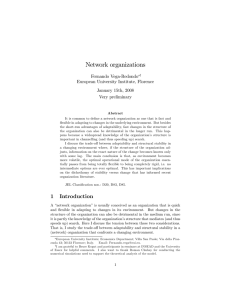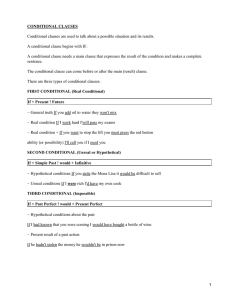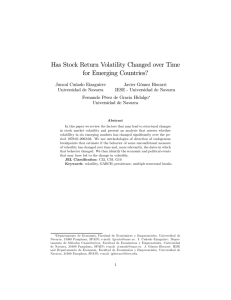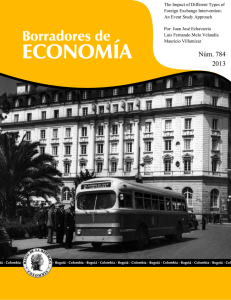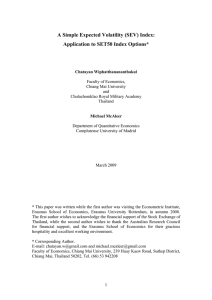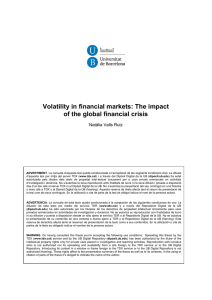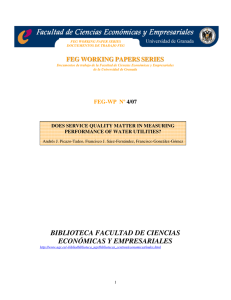the new market effect on return and volatility of spanish stock sector
Anuncio
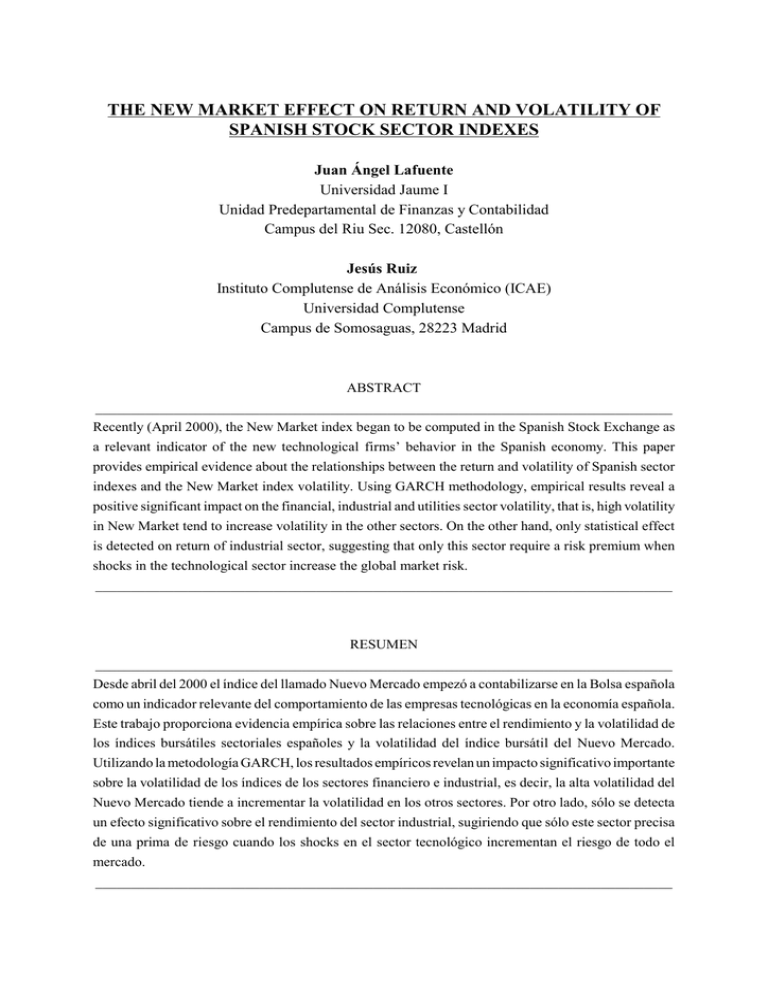
THE NEW MARKET EFFECT ON RETURN AND VOLATILITY OF SPANISH STOCK SECTOR INDEXES Juan Ángel Lafuente Universidad Jaume I Unidad Predepartamental de Finanzas y Contabilidad Campus del Riu Sec. 12080, Castellón Jesús Ruiz Instituto Complutense de Análisis Económico (ICAE) Universidad Complutense Campus de Somosaguas, 28223 Madrid ABSTRACT _________________________________________________________________________________ Recently (April 2000), the New Market index began to be computed in the Spanish Stock Exchange as a relevant indicator of the new technological firms’ behavior in the Spanish economy. This paper provides empirical evidence about the relationships between the return and volatility of Spanish sector indexes and the New Market index volatility. Using GARCH methodology, empirical results reveal a positive significant impact on the financial, industrial and utilities sector volatility, that is, high volatility in New Market tend to increase volatility in the other sectors. On the other hand, only statistical effect is detected on return of industrial sector, suggesting that only this sector require a risk premium when shocks in the technological sector increase the global market risk. _________________________________________________________________________________ RESUMEN _________________________________________________________________________________ Desde abril del 2000 el índice del llamado Nuevo Mercado empezó a contabilizarse en la Bolsa española como un indicador relevante del comportamiento de las empresas tecnológicas en la economía española. Este trabajo proporciona evidencia empírica sobre las relaciones entre el rendimiento y la volatilidad de los índices bursátiles sectoriales españoles y la volatilidad del índice bursátil del Nuevo Mercado. Utilizando la metodología GARCH, los resultados empíricos revelan un impacto significativo importante sobre la volatilidad de los índices de los sectores financiero e industrial, es decir, la alta volatilidad del Nuevo Mercado tiende a incrementar la volatilidad en los otros sectores. Por otro lado, sólo se detecta un efecto significativo sobre el rendimiento del sector industrial, sugiriendo que sólo este sector precisa de una prima de riesgo cuando los shocks en el sector tecnológico incrementan el riesgo de todo el mercado. _________________________________________________________________________________ 1 Introduction In the most recent years technological firms have become a very important factor in the world economic development. They most often provide efficient ways for eventual communications, leading to a general reduction of transaction costs. Spanish economy has also seen the increasing size of this sector and, as a consequence, in April 1 7, 2000 the technical advisory committee of Ibex 35 decided the launching of the New Market index with an initial market value of 10,000 basis points. This market index tries to capture the behavior of Spanish technological companies. The valuation of those kind of firms becomes very complicated because of standard net present value can not be fully applied to their specific capital structure. The recent shortsighted support of investors to any idea around Internet produced speculative bubbles, entailing high increasing valuations in the short –run. However, this trend has dramatically changed, and the market has performed a drastic downward adjustment in the share market prices. For example, along the period covering January to April 2001 one hundred forty-six companies have been removed in the Nasdaq index because of its market price decreased beyond the one dollar. This is an important change relative to similar time period in the previous year, where only forty-six firms are removed. In the Spanish Stock Exchange the companies concerning the New Market, especially Terra, have been also evolved according to a decreasing pattern in the market value. As a consequence, the New Market index, with a systematic fall in its level, achieved in May 31, 2001 a negative accumulated return from its launching, exceeding the two hundred per cent. It is readily apparent that there is a connection between the Nasdaq and the other technological markets in the world. However, another interesting issue is to test for possibly interactions between the technological sector and other ones concerning a certain economy. This is a relevant question for portfolio managers trying in every time period to allocate efficiently the resources of investors. In this paper we provide empirical evidence for the Spanish Stock Exchange about the relationship between the volatility in the technological sector (New Market), and return and volatility in the other main Stock Exchange sectors, that is: financial, utilities and industry. 1 The Ibex 35 is a weighted index by capitalization level, composed of the 35 securities quoted on the Joint Stock Exchange system of the four Spanish Stock Exchanges, which are the most liquid during the period control (there are two ordinary revisions each year, in January and July, respectively). 2 Using GARCH methodology in order to measure New Market volatility we are interested to test if price fluctuations in the technological sector affect both return and volatility in the other exchange sector. After estimating New Market volatility an univariate TARCH (Threshold ARCH) model for each sector, allowing for possibly asymmetries in the volatility, is fitted. For each specification, the New Market estimated conditional standard deviation and variance appear as a potential explaining factor in the average return and conditional risk, respectively. Results suggest that there is a positive significant transmission of volatility from the New Market to the other sectors. The great impact is on the financial sector. Therefore, a shock in the technological sector disseminates on the other ones producing an increase in the risk. This empirical finding suggests that both industry and utilities sectors can be used as alternative allocations to financial sector for investors trying to minimize the impact of the market risk underlying the technological firms. On the other hand, even though the impact of New Market volatility on the returns in the other sectors (utilities, industry, financial) has the expected sign, this is only statistically relevant in the industrial sector. The rest of the paper is organized as follows: section II explains the data set and presents preliminary statistics. In section III the estimation of New Market volatility and methodology to test hypothesis is described. Section IV provides empirical results and, finally, section V summarizes and makes concluding remarks. 2 The Data The data set used in the paper is available in the home page of Sociedad de Bolsas, the Ibex index manager. For each of the following indexes a) Financial Ibex, b) 2 Utilities Ibex, c) Industry Ibex and d) New Market Index , the highest, the lowest, the open and the close daily prices are available. The sample period covers from April 7, K 2 The formula used in the calculation of each index is: Indext = Indext −1 × ∑S i ,t Pi ,t i =1 , where K ∑S i ,t −1 Pi ,t −1 ±J i =1 K is the number of companies included in the index, Pi ,t is the market price at time t of the share i, S i , t is the number of computable shares at time t and J is the correction for possibly capital increases. 3 2000 to May 31, 2001. Overall, we have 287 trading days. However, data observations of the industry, utilities and financial Ibex are used in the current section with descriptive purpose from January 2, 1998. Figure 1 (see appendix 1) presents the time evolution of the close Ibex indexes as well as the New Market close Index. It can be clearly observed that index level in the four sectors are non stationary in mean. Figure 2 (appendix 1) shows the average monthly Garman-Klass (1980) volatility for each sector index before and after the introduction the New Market jointly with the New Market Volatility. For each day, the Garman-Klass statistic is the following: 1 p MAX GKVt = ln tMIN 2 p t 2 p OPEN − [2 ln(2) − 1]ln t CLOSE p t t = 1,2...287 , where ptMAX , p tMIN , p tOPEN and ptCLOSE denote the daily maximum, minimum, open and close price, respectively. This is a more appropriate statistic than the standard deviation when the analyzed series are non stationary. In this case, standard deviation might be misunderstanding because of its value captures the trend rather than the risk or price fluctuation. Figure 2 tries to motivate the analysis by allowing for an initial visual calibration of the impact of the New Market volatility on the other sector volatilities. This figure plot the average per cent volatility for each moth from January 1998 to May 2001, computed from daily Garman-Klass statistics. Figure 2 suggest that, beyond April 2000, only the volatility in the financial Ibex seems to replicate slightly the behavior of the volatility in the technological sector. Because of the non-stationarity in the index levels we use in the analysis the sector returns. Table 1 (appendix 2) presents summary statistics: a) mean, b) standard deviation, c) asymmetry coefficient and d) the excess of kurtosis. Taking into account that the Normal distribution has no asymmetry and an excess of Kurtosis equal to 3, no dramatic discrepancies with this distribution arise. As expected with daily closing index, the mean of returns is close to zero. 3 Volatility Measure and Test Procedure. In this section we explain the methodology used in order to measure the volatility in the New Market and also how to test if volatility in the technological sector affect both return and volatility of industry, utilities and financial sector. 4 A common feature in financial returns is that volatility is changing over time. To incorporate this pattern, Engle (1982) initially proposed the ARCH models and were generalized by Bollerslev (1986). Table 2 (appendix 2) shows the Lagrange-Multiplier tests for autoregressive conditional heteroskedasticity in the market return of all indexes. The empirical value of the test leads to reject the null hypothesis of no ARCH at the 5% significance level, suggesting that the four sector returns have time changing volatility. On the other hand, it is often observed that downward movements in the market are followed by higher volatilities than upward movements of the same magnitude (see for example Engle and Ng (1993)). To account for this pattern, Glosten, Jaganathan, and Runkle (1993) proposed asymmetric impact of the squared innovations in the variance equation through a dummy multiplicative variable. Another alternative is the EGARCH (exponential GARCH) model initially proposed by Nelson (1991) which captures volatility clustering trough the size and the sign of lagged residuals. In order to provide preliminary evidence for the above highlighted pattern Figures 3 to 6 show XY plots of return and Garman-Klass volatility along the period that covering from April 7, 2000 to May 31, 2001. It can be observed that negative and positive returns exhibits no similar pattern in terms of volatility suggesting that volatility responses are not symmetric in all sectors. This is corroborated by the statistics reported in Table 3. Even though the absolute value of the average return is very close in the right and left hand side of the XY plot for al sectors, average volatility is higher under negative returns. Therefore, the previous discussion suggest that to represent the dynamics of intraday returns in each stock exchange sector a model should be used capturing a) time changing volatility and b) the presence of asymmetries in the response of volatility under similar trends with opposite sense. Our main objective is to analyze the impact of New Market volatility in both returns and volatility in the other sectors. To do this, first we posit the following specification for New Market index returns: R NM ,t = α + βR NM ,t −1 + ε t , (1) ( (2) ) ε t / Ω t −1 ~ N 0, σ t2 , p q j =1 j =1 2 2 2 2 σ NM ,t = γ 0 + ∑ γ i σ NM ,t − j + ∑ φ j ε t − j + δε t −1 d t −1 , (3) 5 where d t −1 1 if ε t −1 < 0 = , 0 if ε ≥ 0 t −1 that is, an AR(1) in the mean equation, with a TARCH model for the conditional variance. The parameters φ j associated with the standardized lagged innovations measure the leverage effect in different time periods. Under asymmetries there would appear at least one significant parameter at conventional levels. Under the previous assumption of Gaussian conditional distribution of disturbances, the log-likelihood function can be written as follows: l (µ ) = − 1 T ln 2π − 2 2 ε2 ln σ t2 − t , σ t2 t =1 T ∑ where T denotes the sample size and µ the parameter vector to be estimated. The log likelihood function is highly nonlinear in µ and a numerical maximization technique is required. Table 4 presents the maximum likelihood 3 estimation of equations (1) to (3) for p=1 and q=2 . As expected, the estimated parameter δ is significant at the 5% level, capturing the presence of asymmetries in the impact of new shocks in the market. On the other hand, as it is often observed in financial time series, the parameter γ 1 is near to one, revealing high persistency in the conditional variance. This way, a shock in the variance equation tends to produce very persistent effects. Table 5 provides diagnosis statistics for the estimated model, showing that the considered specification successfully captures the behavior pattern of New Market returns. No evidence of additional ARCH structure is detected, and interestingly, the null hypothesis of Normality in the empirical distribution of standardized residual is not rejected at the 5% level. Also, Ljung-Box statistic exploring additional structure in the not standardized residuals leads to accept the null hypothesis of no correlation. Figure 7 shows the time evolution of the estimated conditional variance in the New Market. Once we have estimated the New Market volatility, the following step is to test if this measure of risk have explaining power about the time evolution of returns and volatility in the other stock exchange sectors. We make jointly both objectives with GARCH methodology since evidence of time changing volatility in the financial, industrial and utilities sectors is previously provided. 3 The number of lags is chosen according to the maximum value of the likelihood function. The numerical algorithm used is the BHHH (Berndt, Hall, Hall, and Hausman). 6 The following specification for the sector s is used: R s ,t = β s ,0 + β s ,1 R s ,t −1 + β s , 2σˆ NM ,t −1 + u s ,t , ( ) u s ,t / Ω t −1 ~ N 0, σ s2,t , σ 2 s ,t = γ s ,0 + p ∑γ s ,i σ j =1 where d t −1 2 s ,t − j (4) (5) + q ∑φ j =1 2 s , j u s ,t − j 2 + δ s u s2,t −1 d t −1 + ϑ sσ̂ NM ,t −1 , (6) 1 if ε t −1 < 0 , = 0 if ε ≥ 0 t −1 and s = f, in, ut, denotes the financial, industrial and utilities sector, respectively. The previous specification have the two following characteristics: a) in the mean equation the lagged conditional standard deviation of the New Market is included as an 4 explicative variable and b) the lagged conditional variance of the New Market appears as a potential explaining factor in the variance equation. These two characteristics allow for testing the impact of conditional risk in the New Market on both return and volatility in each stock exchange sector from one trading session to the next one. If New Market volatility is a relevant factor to explain return and (or) volatility in a sector the parameter β s , 2 and (or) ϑ would be significant at conventional levels. Under significant transmission of volatility from the New Market, the sign of ϑ s determine the nature of the interaction. If New Market fluctuations tend to produce a higher destabilization of market prices in other sector the estimated parameter should be positive. Relative to parameter β s , 2 this can be interpreted as price of the risk in terms of returns, that is, a risk premium. It is expected that a higher risk in the technological sector, which definitely increases the global risk of a diversified portfolio, will produce a transitory higher claim in the market about the performance in each sector. Therefore, the sign of the estimated parameter δ s concerning equation (4) should be positive for each stock exchange sector. 4 Empirical Results In this section we provide explanation about empirical results underlying in the estimation of Equations (4) and (6) under the assumptions pointed out in section 3. 4 We include the standard deviation rather the variance in order to preserve the measure units. 7 Tables 6 to 8 provide the maximum likelihood estimation for each sector with the following lag structure: a) financial sector: p=1 and q=0, b) industrial sector: p=2 and q=1, and c) utilities sector: p=1 and q=1. All specifications are selected according to the maximum level achieved in the likelihood function. Several interesting aspects arise from these tables. Relatives to the estimated premium risk in each sector respect to the New Market volatility, all estimated parameters ( βˆ s , 2 ) have the expected sign. Moreover, the null hypothesis H 0 : β s , 2 = 0 against the alternative one H 1 : β s , 2 > 0 is rejected at the 5% significance level. The additional risk in the market produced through shocks in the technological sector induce to averse risk agents requiring an additional return for support a high level of uncertainty in the market value of their portfolios. Even though βˆ s , 2 > 0 , s = f , in, ut , no rejection of the null hypothesis at the 5% significance level is observed, except for the industrial sector. This can be interpreted as only agents investing in equities in this sector effectively require, in aggregate terms, a risk premium as a consequence of the increase in the global market risk. The nature of this effect is transitory. To clarify this, under the assumption β s ,1 < 1 s = f , in, ut , recursively substituting into equation (4), the sector return can be expressed as follows: R s ,t = β s,0 1 − β s ,1 + β s,2 ∞ ∞ j =0 j =0 ∑ β sj,1σ NM ,t −1− j + ∑ β sj,1u s,t − j . (7) For all the sectors, estimated parameter β s ,1 satisfies the above restriction concerning the absolute value. Therefore, equation (7) applies. It can be observed that ∂R s ,t ∂σˆ NM ,t − j = β s , 2 β sj,1−1 . Therefore, if the estimated parameter β s ,1 is not significant, an increase in the New Market volatility will only produce instantaneous effects in the s sector return. Relative to the impact of New Market volatility on the other sector volatilities our empirical results show a significant effect in all three analyzed sectors. All parameters ϑˆ s , 2 > 0 , s = f , in, ut are significant at the 5% level, suggesting that there is a positive transmission of volatility. Therefore, a higher risk in the New Market tends to anticipate an increase of volatility in the other sectors. Even though the risk in all three sectors is not independent of the one concerning the New Market, the impact on industrial and utilities sector is negligible relative to the effect on the financial one. Even though the financial sector is more volatile, the ratio between the estimated 8 parameter ϑˆ s , 2 and the average estimated conditional volatility is extremely higher in 5 the financial sector . The nature of the impact is not similar in all sectors. As a difference of the impact on the industrial and utilities sector, the effect on financial sector volatility impact is only transitory. To better understanding, recursively substituting into equation (6) and assuming that γ s ,1 < 1 the conditional volatility in the sector s can be expressed as follows: σ s2,t = where z t −1 = q ∑φ j =1 2 s , j u s ,t − j γ s ,0 1 − γ s ,1 + ∞ ∞ j =0 j =0 2 ,t −1− j , ∑ γ sj,1 zt −1− j + ϑ s ∑ γ sj,1σ NM (8) + δ s u s ,t −1 d t −1 . Taking into account that the estimated parameter satisfies this constraint equation (8) applies for all three analyzed sectors. From equation (8) yields ∂σ s2,t ∂σ 2 NM ,t − j = ϑ s γ sj,−11 , and as a consequence, if estimated parameter γ s ,1 is not significant the increase of the New Market volatility will produce only instantaneous effects on the s sector volatility. The specification of the variance equation in the financial sector does not require the parameter γ f ,1 . On the other hand, for both industrial and utilities sector the estimated parameter γ in ,1 and γ ut ,1 are significant, respectively. Both characteristics suggest that industrial and utilities sector accommodates shocks initially carried out in the technological firms with a lower speed that the financial one. Figures 8 to 10 show the time evolution of the estimated conditional variance in the financial, industrial and utilities sectors. Figures 7 and 8 reveal that conditional volatility in the financial and technological sector evolves with a similar time changing pattern. This characteristic does not appear when comparing figure 7 with figures 9 and 10. This is due to the different nature in the impact. Whereas the impact of New Market volatility on industrial and utilities sector is highly persistent the effect on the financial sector is only transitory and instantaneous. Figures 7 and 8 suggest that financial and technological sectors share a common ARCH feature. Under such hypothesis, there is a linear combination of both market index returns with constant risk along time. This is an interesting issue for further research that can be tested following methodology in Engle and Kozicki (1993) for any two sectors. 5 These ratios are: a) financial sector: 1,289.2; b) industrial sector: 19.2 and c) utilities sector: 124.7 9 Finally, Tables 9 to 11 provides three diagnosis kinds of statistics for the estimated models. The Lagrange multiplier test on the standardized residuals shows no remaining ARCH structure. This is confirmed by the Ljung-Box statistic. Relative to mean specification the Ljung-Box statistic also reveals no additional structure of correlation in the not standardized residuals. Also, the Bera-Jarque (1981) reveals that the assumption of Normal conditional distribution is adequate in order to represent the stochastic behavior of the return for the three analyzed sectors. 5 Summary and concluding remarks In this paper we provide empirical analysis about the relationships between New Market volatility and the stochastic behavior of Spanish Stock Exchange Sectors. In particular, two issues are explored: a) the impact of New Market volatility in the market returns in other sector (financial, industrial and utilities), and b) the link between the New Market volatility and the risk in each of the previous sectors. Daily closing data covering the period from April 7, 2000 (the launching date for the New Market index in the Spanish economy) to May 31, 2001 are used. We first estimated the volatility in the New Market by fitting a threshold autoregressive conditional heteroskedasticity (TARCH) model, which allows for capturing asymmetries in the impact of innovations in the conditional variance. We test the two above hypothesis by estimating again a TARCH model for each market returns of the financial, industrial and utilities sector, where the lagged conditional standard deviation appears as a potential explaining factor in the mean equation. Similar characteristic applies to the variance equation relative to the conditional variance of the New Market. Our empirical results show a positive transmission of volatility from the New Market to the other ones, that is, a higher volatility in the technological sector tends to anticipate a increase in the volatility in the financial, industrial and utilities sector. This empirical pattern is a relevant issue for portfolio managers. The increase in the New Market risk produces a higher volatility in the other sectors, being the financial one in where a most relevant impact appears. Even though there is no sector with orthogonal volatility behavior relative to New Market volatility, the nature of the effect is not similar. In both industrial and utilities sectors the New Market volatility impact is 10 highly persistent, as a difference of the financial sector in where only a transitory impact is detected. Concerning the relationship between the New Market volatility and returns in the other sectors, even though the sign of the estimated parameter is the expected one, empirical results only show a significant link in the industrial sector. This implies that only the industrial sector requires a risk premium when market risk increases from technological shocks. Taking into account that the New Market produces significant impact in all sectors’ volatility, an interesting further research is to test for common ARCH features between each two sectors, following methodology proposed in Engle and Kozicki (1993). If there were such pattern there would be possible to identify a combined portfolio with two sectors having constant risk rather than changing volatility. References Bera, A.K. and C. M. Jarque (1981): “An Efficient Large Sample Test for Normality of Observations and Regression Residuals”, Working Paper in Econometrics, 40, Australian National University, Canberra. Bollerslev, T. (1986) “Generalized Autoregressive Conditional Heteroskedasticity,” Journal of Econometrics, 31: 307–327. Engle, R. F. (1982) “Autoregressive Conditional Heteroskedasticity with Estimates of the Variance of U.K. Inflation,” Econometrica, 50: 987–1008. Engle R. F. and S: Kozicki (1993) “Testing for Common Features”, Journal of Business & Economic Statistics, 11 (4): 386-90. Engle, R. F. and V. K. Ng (1993) “Measuring and Testing the Impact of News on Volatility,” Journal of Finance, 48: 1022–1082. Garman, M. and M. Klass (1980): “On the Estimation of Security Price Volatilities from Historical Data”, Journal of Business, 53: 67-78. Glosten, L.R., R. Jagannathan, and D. Runkle (1993) “On the Relation between the Expected Value and the Volatility of the Normal Excess Return on Stocks,” Journal of Finance, 48: 1779–1801. Nelson, D. B. (1991) “Conditional Heteroskedasticity in Asset Returns: A New Approach,” Econometrica, 59: 347–370. 11 Appendix 1. Figures Daily Closing Index Sample: January 2, 1998 to May 31, 2001 30000.00 25000.00 New Market launching: April 7, 2000 20000.00 15000.00 10000.00 5000.00 0.00 Industry Utilities Financial New Market Figure 1 Average monthly Garman-Klass Volatility Sample: January 2, 1998 to May 31, 2001 New Market launching: April 7, 2000 M ay Se -9 pt 8 em be r98 Ja nu ar y99 M ay Se -9 pt 9 em be r99 Ja nu ar y00 M ay Se -0 pt 0 em be r00 Ja nu ar y01 M ay -0 1 Ja nu ar y- 98 0.16 0.14 0.12 0.10 0.08 0.06 0.04 0.02 0.00 Industry Utilities Financial New Market Figure 2 14 XY Plot Return-Volatility Financial Sector Volatility 0.15 0.10 0.05 0.00 -0.05 -0.03 -0.01 0.01 0.03 0.05 Return Figure 3 XY Plot Return-Volatility Industrial Sector 0.04 Volatility 0.03 0.02 0.01 0.00 -0.04 -0.02 0.00 0.02 0.04 Return Figure 4 15 XY plot Return-Volatility Utilities Sector 0.20 Volatility 0.15 0.10 0.05 0.00 -0.06 -0.04 -0.02 0.00 0.02 0.04 0.06 0.08 0.12 Return Figure 5 XY Plot return-Volatility Technological Sector 0.80 0.70 Volatility 0.60 0.50 0.40 0.30 0.20 0.10 0.00 -0.12 -0.08 -0.04 0.00 0.04 Return Figure 6 16 New Market Conditional Variance 0.0040 0.0035 0.0030 0.0025 0.0020 0.0015 0.0010 0.0005 0.0000 June 30, 00 September 29, 00 December 29, 00 March 31, 01 Figure 7 Conditional Variance of Financial Sector 0.0014 0.0012 0.0010 0.0008 0.0006 0.0004 0.0002 0.0000 June 30, 00 September 29, 00 December 29, 00 March 31, 01 Figure 8 17 Conditional Variance of Industrial Sector 0.0003 0.0003 0.0002 0.0002 0.0001 0.0001 0.0000 June 30, 00 September 29, 00 December 29, 00 March 31, 01 Figure 9 Conditional Variance of Utilities Sector 0.0008 0.0007 0.0006 0.0005 0.0004 0.0003 0.0002 0.0001 0.0000 June 30, 00 September 29, 00 December 29, 00 March 31, 01 Figure 10 18 Appendix 2. Statistical Tables Table 1. Main statistics of Daily Index Returns Ibex Index Mean Standard Deviation Asymmetry Excess of Kurtosis New Market Industry Utilities Financial -0.0296 -0.0665 0.0202 -0.3675 0.9070 1.8583 1.6779 3.0952 -0.3948 0.1247 -0.1701 -0.1464 3.5669 2.9630 3.7409 3.4105 Table 2. LM test for ARCH(p) structure in sector returns p Industry Utilities Financial (*) New Market 1 32.69 (0.000) 12.91 (0.000) 51.95 (0.000) 9.62 (0.002) 2 34.93 (0.000) 10.76 (0.000) 31.57 (0.000) 5.74 (0.003) 3 34.48 (0.000) 7.98 (0.000) 41.75 (0.000) 4.09 (0.007) 6 19.59 (0.000) 6.70 (0.000) 28.63 (0.000) 2.29 (0.036) Notes: The sample period used is from January 2, 1998 to May 31, 2001. (*) The sample period is from April 7, 2001 to May 31, 2001. In all cases the test is performed using the residuals from a least squares regression of the market index on a constant. The test statistic for the joint significance of the p-lagged squared residuals is the number of observations times the R-squared from the regression. The asymptotic distribution of the F-statistic is a χ 2p . In parenthesis are the p-values. Table 3. Average return and volatility under positive or negative returns. Positive Returns Negative Returns Average Average Average Average Sector return Volatility return Volatility Financial 0.0129 0.0182 -0.0129 0.0219 Industrial 0.0066 0.0078 -0.0073 0.0095 Utilities 0.0146 0.0228 -0.0147 0.0255 New Market 0.0226 0.0605 -0.0250 0.0681 19 Table 4. Maximum likelihood estimation of the TARCH model for New Market index returns Mean Equation Variance Equation α β γ0 γ1 φ1 φ2 δ -0.00365 0.05317 0.00002 0.93044 0.16066 -0.16747 0.09752 (0.00132) (0.04418) (0.00002) (0.03057) (0.04932) (0.04534) (0.03799) Note: In parenthesis are the asymptotic standard errors. Table 5. Diagnosis of TARCH specification for New Market Index returns (a) (b) (e) LM test Ljung-Box test BJ test (e) (d) 2 lags 3 lags SR 0.06 0.08 0.32 8.71 9.27 0.89 (0.81) (0.92) (0.81) (0.56) (0.51) (0.64) Notes: (b) (c) 1 lag (a) NSR Lagrange multiplier test to test ARCH structure on standardized residuals. Ljung-Box test uses 10 lags. (c) Standardized residuals. (d) Not standardized residuals. Bera-Jarque test on standardized residuals. In parenthesis are the p-values. Table 6. Maximum likelihood estimation of TARCH specification for Financial sector index returns Mean Equation Variance Equation β f ,0 β f ,1 β f ,2 -0.00123 -0.00746 0.04654 (0.00366) (0.05611) (0.13953) γ f ,0 -0.00003 φ f ,1 δf ϑf -0.07677 0.32703 0.32616 (0.00003) (0.03693) (0.15007) (0.06123) Note: In parenthesis are the asymptotic standard errors. Table 7. Maximum likelihood estimation of TARCH specification for Industrial sector index returns Mean Equation Variance Equation β in ,0 β in ,1 β in , 2 γ in ,0 γ in ,1 φ in ,1 φ in , 2 δ in ϑin -6 -0.00312 0.01127 0.08604 0.8 10 0.89216 0.11270 -0.16863 0.09181 0.00135 -7 (0.00102) (0.04051) (0.03636) (0.4 10 ) (0.00733) (0.03747) (0.03752) (0.00710) (0.00048) Note: In parenthesis are the asymptotic standard errors. 20 Table 8. Maximum likelihood estimation of TARCH specification for Utilities sector index returns Mean Equation Variance Equation β ut ,0 -0.00321 β ut ,1 0.01361 β ut , 2 0.07787 γ ut ,0 0.00002 (0.00365) (0.04893) (0.13074) γ ut ,1 0.81064 φ ut ,1 -0.03110 δ ut 0.16298 ϑut 0.02631 (0.00002) (0.0569) (0.02625) (0.06296) (0.01341) Note: In parenthesis are the asymptotic standard errors. Table 9. Diagnosis of TARCH specification for Financial index returns (a) (b) (e) Ljung-Box test BJ test LM test (e) (d) 2 lags 3 lags SR NSR 0.00 0.69 0.50 13.60 16.30 3.20 (0.96) (0.50) (0.67) (0.19) (0.09) (0.20) Notes: (b) (c) 1 lag (a) Lagrange multiplier test to test ARCH structure on standardized residuals. Ljung-Box test uses 10 lags. (c) Standardized residuals. (d) Not standardized residuals. Bera-Jarque test on standardized residuals. In parenthesis are the p-values. Table 10. Diagnosis of TARCH specification for Industrial index returns (a) (b) (e) Ljung-Box test BJ test LM test (e) (d) 2 lags 3 lags SR NSR 0.34 0.16 0.18 11.08 10.63 4.48 (0.55) (0.84) (0.91) (0.35) (0.39) (0.11) Notes: (b) (c) 1 lag (a) Lagrange multiplier test to test ARCH structure on standardized residuals. Ljung-Box test uses 10 lags. (c) Standardized residuals. (d) Not standardized residuals. Bera-Jarque test on standardized residuals. In parenthesis are the p-values. Table 11. Diagnosis of TARCH specification for Utilities index returns (a) (b) (e) Ljung-Box test BJ test LM test (e) (d) 2 lags 3 lags SR 0.50 0.32 0.34 10.09 6.55 0.96 (0.48) (0.72) (0.79) (0.43) (0.77) (0.62) Notes: (b) (c) 1 lag (a) NSR Lagrange multiplier test to test ARCH structure on standardized residuals. Ljung-Box test uses 10 lags. (c) Standardized residuals. (d) Not standardized residuals. Bera-Jarque test on standardized residuals. In parenthesis are the p-values. 21

